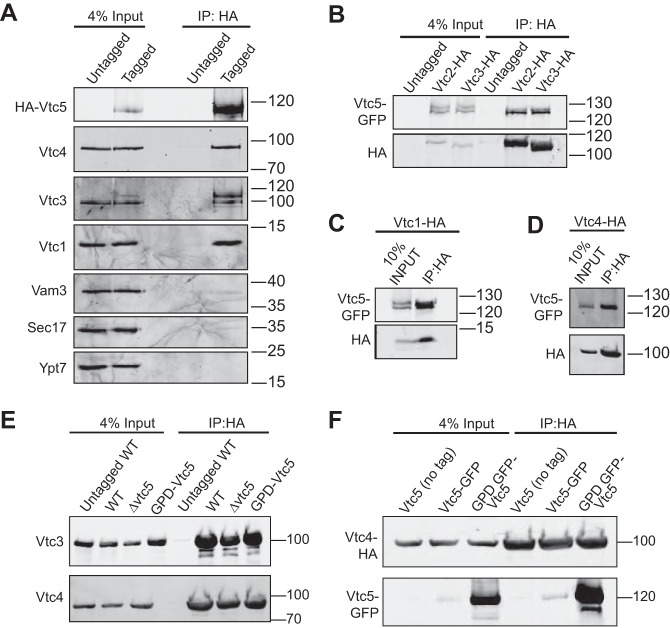FIGURE 2.
Physical interaction between Vtc5 and other VTC subunits. A, co-immunoprecipitation of Vtc5 and other VTC subunits. Vacuoles were isolated from BJ3505 cells expressing Vtc5 under the control of the ADH1 promoter with or without an HA tag. The detergent-solubilized membranes were immunoprecipitated (IP) using anti-HA monoclonal antibodies. Adsorbed proteins were analyzed by SDS-PAGE and Western blotting using monoclonal mouse antibodies directed against the HA tag or polyclonal antibodies against the entire proteins. B, both VTC isoforms interact with Vtc5. Vacuoles were isolated from BJ3505 strains expressing either Vtc2-HA or Vtc3-HA and a C-terminally GFP-tagged version of Vtc5 (Vtc5-GFP), all under control of the respective endogenous promoters. HA-tagged proteins were immunoprecipitated and analyzed as in A. C and D, co-immunoprecipitation of Vtc5 with Vtc1 and Vtc4. The same experiment as in B was performed using vacuoles isolated from a strain expressing Vtc1-HA (C) or Vtc4-HA (D). E, Vtc5 does not influence the interaction between other VTC subunits. VTC5 was deleted or overexpressed from the GPD1 promoter in BJ3505 cells carrying HA-tagged or untagged Vtc4. Vacuoles were isolated and subjected to immunoprecipitation as in A, using antibodies directed against GFP or against the HA tag. F, influence of Vtc5 expression level on the Vtc4-Vtc5 interaction. VTC5 was expressed in BJ3505 VTC4-HA under the control of its endogenous promoter (Vtc5-GFP) or the strong GPD1 promoter (GPD1-GFP-Vtc5). Vtc4-HA was pulled down from isolated vacuoles as in C, and adsorbed Vtc5-GFP was detected by Western blotting for its GFP tag. The migration of relevant molecular mass markers (size in kDa) is indicated on the right-hand side of the panels.

